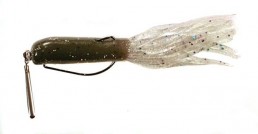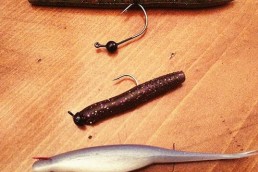Three Bass Finesse Rigs that will Blow Your Mind
SHARE THIS POST
Curse thee, YouTube. Each winter, you cost those of us who don’t like ice fishing way too much money. We bass anglers can spend hour after hour watching anglers of all skill levels catch fish after fish on things that aren’t in our tackle boxes. What’s worse, YouTube, you’re a just a click away from websites where we can punch in credit card numbers and stock up on these things we’ve never used, but which convincingly catch fish on your videos.
As we watch these videos, we envision our own lakes, casting from kayaks or boats, catching fish like YouTube content providers do.
We’re going to look at three finesse-y rigs that are current stars of YouTube: the Damiki Rig, Slider Worms and a Jika-rigged tube bait. These rigs don’t make much noise, acting like a gamefish’s typical prey. They don’t call a lot of attention to themselves, but act like minnows and crayfish going about their daily business, trying to not get eaten. They are outstanding finesse rigs.
Damiki rig
Basically a soft plastic jerkbait on an open-hook jig, the rig got its name because the original featured a jighead and Armor Shad from the Damiki company. I watched a YouTuber who calls himself BassGeek catch a giant smallmouth somewhere down south on a 1/2-ounce Drophead jighead from Ledgehead Lures, and searched Dropheads online. Turns out they cost $7.25 for a three-pack. I didn’t order any—yet. I also scanned for the Damiki Armor Shads, which look like your basic 3-inch Baby Fluke.
BassGeek fished a 1/2-ounce Drophead on 6-pound fluorocarbon and a medium action rod—seems like too light of a setup for a 1/2-ounce jighead, but he liked it plummeting down to the school 40 feet deep and being able to keep it directly below his rod tip when the wind pushed his boat around a bit. Once the lure was down there, his main approach was to let it hover and quiver. Occasionally he’d trigger bites from the fish he saw on his graph by giving the reel handle a quick turn.
Two important things about the jighead. First, it should have a 90-degree hook eyelet—the eyelet should be sticking straight up from the top of the head. That helps keep it hanging horizontal amongst your target fish. Second, it ought to have realistic eyeballs to look more like a real minnow.
I was sorely tempted to buy some Dropheads and Damiki Armor Shads, but fought off the urge. I perused my tackle and found a pack of VMC Mooneye Jigs and one paired nicely with a trimmed Zoom Fluke in the baby bass pattern. I also discovered a three-pack of 1/4-ounce jigheads in the watermelon color from Revenge Baits. These matched magnificently with a Mud-Minnow-pattern Hula StickZ from Z-Man that I trimmed to 3 inches. I’m already envisioning pulling some big bass over the side of the kayak from a couple of deep, clear lakes this spring.
Charlie’s Sliders
The late Charlie Brewer belongs on the Mount Rushmore of finesse anglers, coming up with the original Slider head and worm. I just got his book Charlie Brewer on Slider Fishin’, and it is going to be excellent winter reading. First published in 1978, it extolls the “Do Nothing” method of fishing with light line and the unique, flat jigheads that Brewer developed to fish the lakes around his home in Lawrenceburg, Tenn. You can get your own copy for a bargain price of $6.95. While you’re at it, you can do what I did and get free shipping by ordering sufficient Slider Heads, Slider Worms and Double Action Grubs (which we now would call swimbaits) to go over the $50 mark. That makes shipping free.
Slider fishing is as basic as bass casting gets. I watched an hour-long YouTube video, edited from the original, which was made in 1988. It features Charlie and his buddy Foxy Griffin talking about all the main components of Slider fishing, with extra stuff about how Charlie came up with the rig.
Are you enjoying this post?
You can be among the first to get the latest info on where to go, what to use and how to use it!
Basically, back in 1988, you just rigged a 4-inch Slider Worm on one of the flat jigheads, cast it on 6- or 4-pound test monofilament, counted it down to the depth you wanted it to travel and then reeled very slowly. That’s about as “do nothing” as it gets. The video details the gear of the day which included short spinning rods and small spinning reels, so chosen to be light and comfortable to use. Charlie recommends taping the reel to the all-cork rod handle, (known as the Tennessee handle) to keep the combo lighter and more comfortable in the hand.
I don’t think I’ll change from my 7-foot, medium-light Shimano Convergence rods with the inexpensive Sedona spinning reels or go back to monofilament instead of the braided Power Pro and 8-pound Seaguar AbrazX fluorocarbon leader. I can’t wait to start casting some of those baits and doing nothing other than reeling to catch bass with them.
Jika tubes
The Jika rig (properly pronounced ZEE-ka rig) is a fairly recent Japanese import that has a free-swinging weight below a hook, usually rigged weedless into a plastic bait. Fortunately I already had a good supply of tungsten drop-shot weights from Motley Fishing. They are the least-expensive tungsten weights I could find. I also have a bunch of Mizmo and Cruncher tubes that I bought last March at the Ultimate Outdoors Show in Grand Rapids, Michigan. Having the tubes was fortunate, because although the Jika can be used with about any soft plastic, I found a YouTube video that showed how it works with a plastic tube lure.
The excellent, short video on the AnglingBuzz channel features Capt. Ben Wolfe of Sport Fish Michigan, which is a group of guides and charter captains. Capt. Wolfe shows succinctly how to rig a cylindrical drop-shot weight on a split ring that goes through the eyelet of an extra wide-gap hook, with a tube Texas-rigged on the hook. Man, the underwater footage of that tube bouncing just about the bottom made me wish I could jump in the water and eat it. It just looked great. Plus, Capt. Wolfe points out the Jika setup lets the weight directly contact the bottom, giving the angler better feel than a jighead rigged inside the plastic would. A bonus is the whole rig is heavy enough to cast on a baitcast combo.
Some Jika rigs have two split rings; some have one. I rigged this Cruncher Tube for the picture with just one split ring because that’s how Capt. Wolfe did it. I really am looking forward to targeting smallmouths with this just as soon as possible.
If you’re like me, I bet you already envision a big black bass, halfway out of the water, trying to shake free of one of these rigs.
MWO
Dave Mull of Paw Paw, Mich. has spent his career communicating the outdoors experience and runs Inner Viking Media. He enjoys kayak fishing for anything that swims in the lakes and rivers of the Midwest and beyond, and even uses his MirroCraft, from time to time.
MWO
SHARE THIS POST
Did you enjoy this post?
You can be among the first to get the latest info on where to go, what to use and how to use it!
Dave Mull
Dave Mull of Paw Paw, Mich. has spent his career communicating the outdoors experience and runs Inner Viking Media. He enjoys kayak fishing for anything that swims in the lakes and rivers of the Midwest and beyond, and even uses his MirroCraft, from time to time. Available for seminars.


